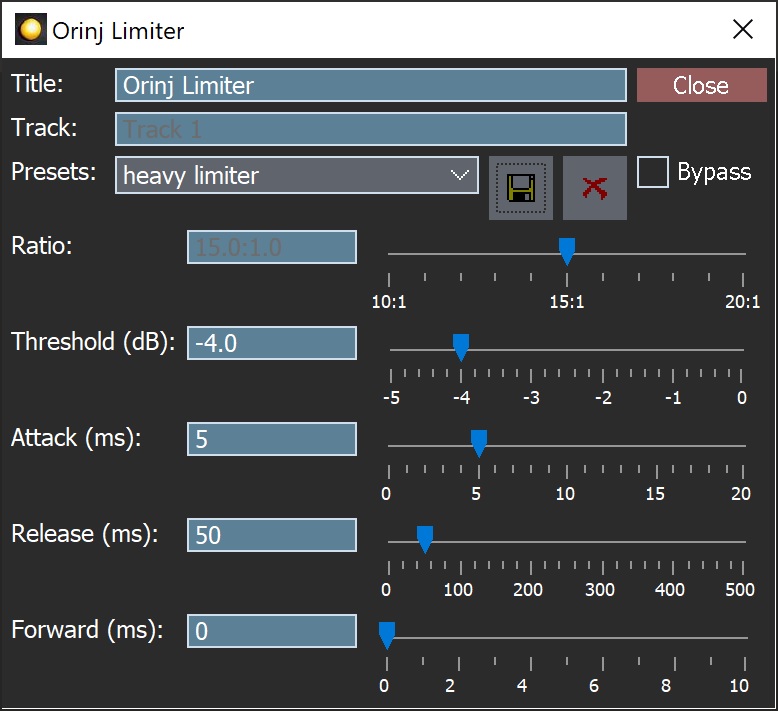Orinj version 7.0.0
The Orinj Limiter is a compressor. It adjusts the amplitude of the incoming signal automatically and softens amplitude changes. The difference between a standard compressor and the limiter is that the limiter uses high compression ratios and fast attacks and releases. Limiters prevent overload on analog systems and prevent clipping in digital signals. An explanation of how compressors work is provided in the topic Orinj Compressor.
An example of the Orinj Limiter
The following sound sample contains four bars of a drum track. The first half of the sample does not use a limiter. The second half uses a limiter with threshold -5 dB, compression of 10:1, attack of 1 ms, and release of 10 ms. The limiter looks ahead by 1 ms. A gain of 4 dB is applied to the track after the limiter. In the first half of the sample, without the limiter, the snare and kick clip. Because of this, the snare ring is lost. In the second half of the sample, the snare does not clip and the snare ring can be heard.
Click to play this example with a limiter.
Using the Orinj Limiter
The Orinj Limiter can be added to tracks, auxiliary channels, and the master channel in the multitrack session view and to waves in the single wave view.
- To add the effect to a track in the session, first click on the track to select it. Click on Effect, Dynamics, and then on Orinj Limiter in the menu.
- To add the effect to an auxiliary channel in the session, click on Track, then Groups / Aux Channels, and then on Aux Channel Controls in the menu. In the auxiliary channel control dialog, click on the Add button.
- To add the effect to the master channel in the session, click on Track and then on Master Channel in the menu. In the master channel dialog, click on the Add button.
- To add the effect to a wave in the single wave view, click on Effect, Dynamics, and then on Orinj Limiter in the menu.
You will see the following dialog.

When the dialog becomes visible, the limiter has been added. Adjust the limiter parameters in the dialog and click on Close. The parameters of the Orinj Limiter are described below.
Orinj Limiter parameters
See Orinj Effects for notes on the Title, Track, Presets, and Bypass controls. The remaining Orinj Limiter controls are as follows.
- Ratio: Use this slider to set the compression ratio of the limiter. This is the ratio at which the difference between the amplitude of the signal and the threshold is adjusted. The ratio in the limiter is high, between 10:1 and 20:1. A limiter that has a compression ratio of 20:1 or over is known as a "hard" limiter or a "brick wall" limiter.
- Threshold: Use these controls – the box and the slider – to set the threshold of the limiter. The threshold of the limiter is measured in decibels and is high, between -5 dB and 0 dB, where 0 dB is the maximum amplitude that the digital signal can carry, given the sampling resolution of the signal.
- Attack: Use these controls – the box and the slider – to set the attack of the limiter. The attack is the time it takes for the limiter to change the amplitude of the signal so that the compression ratio moves from 1:1 to the needed compression ratio. The attack of the limiter is short. It is measured in milliseconds (ms) and can be between 0 ms and 20 ms.
- Release: Use these controls – the box and the slider – to set the release of the limiter. The release is the time it takes the limiter to change the amplitude of the signal so that the compression ratio changes from the needed compression ratio back to 1:1. The release is also short. It is measured in milliseconds (ms) and can be between 0 ms and 500 ms.
- Forward: Use these controls – the box and the slider – to set the amount of time that the limiter looks ahead when adjusting the amplitude of the signal. With value of 5 ms, for example, the limiter will begin to adjust the amplitude of the signal 5 ms before that signal reaches a compression threshold. This look ahead time parameter is included to allow quick compression at the very beginning of signal peaks, but without a very short attack, since very short attacks can change the underlying form of the signal and introduce distortion. If the attack of the limiter is also set at 5 ms, then the limiter will reach its full compression / expansion ratio at the moment at which the signal reaches the specific compression / expansion threshold. The amount of time that the limiter looks ahead is measured in milliseconds and can be between 0 ms and 10 ms.
See Orinj Effects for additional notes on: where Orinj effects can be used, using boxes and sliders that impact the same parameter (such as the box and slider for the limiter attack), applying effects to mono and stereo waves, and using effects during playback. See Orinj Working with effects for additional information on creating, modifying, moving, and removing effects. See Compressor / expander (of dynamics) for additional information on the compressors in audio processing.

Add new comment